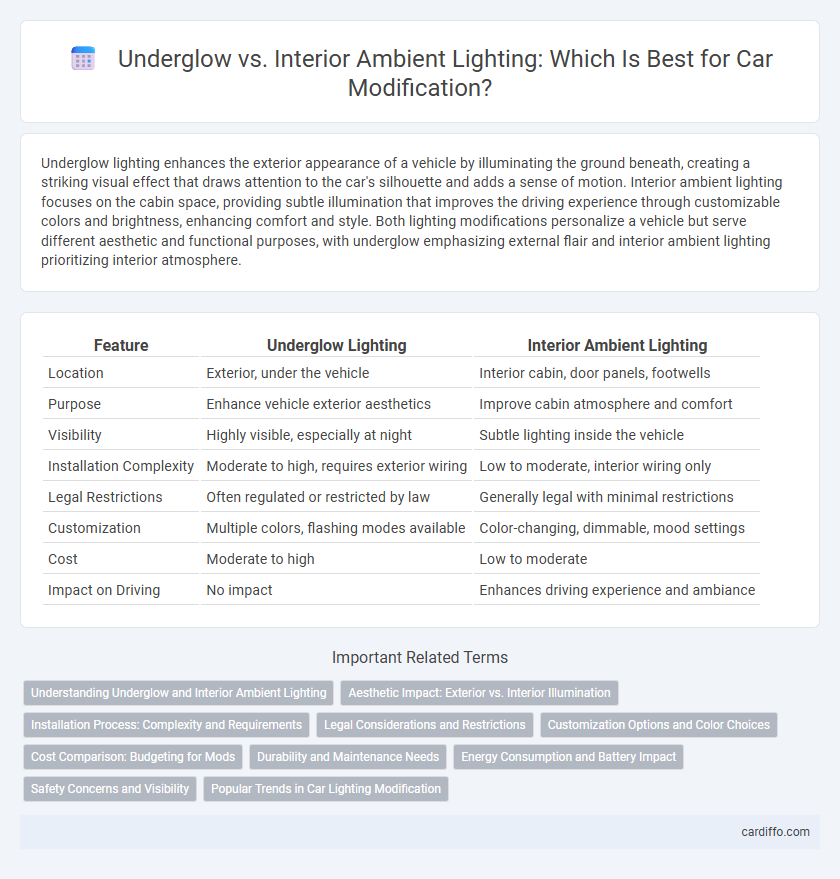Underglow lighting enhances the exterior appearance of a vehicle by illuminating the ground beneath, creating a striking visual effect that draws attention to the car's silhouette and adds a sense of motion. Interior ambient lighting focuses on the cabin space, providing subtle illumination that improves the driving experience through customizable colors and brightness, enhancing comfort and style. Both lighting modifications personalize a vehicle but serve different aesthetic and functional purposes, with underglow emphasizing external flair and interior ambient lighting prioritizing interior atmosphere.
Table of Comparison
| Feature | Underglow Lighting | Interior Ambient Lighting |
|---|---|---|
| Location | Exterior, under the vehicle | Interior cabin, door panels, footwells |
| Purpose | Enhance vehicle exterior aesthetics | Improve cabin atmosphere and comfort |
| Visibility | Highly visible, especially at night | Subtle lighting inside the vehicle |
| Installation Complexity | Moderate to high, requires exterior wiring | Low to moderate, interior wiring only |
| Legal Restrictions | Often regulated or restricted by law | Generally legal with minimal restrictions |
| Customization | Multiple colors, flashing modes available | Color-changing, dimmable, mood settings |
| Cost | Moderate to high | Low to moderate |
| Impact on Driving | No impact | Enhances driving experience and ambiance |
Understanding Underglow and Interior Ambient Lighting
Underglow lighting refers to exterior LED lights installed beneath a vehicle to enhance its appearance with a vibrant glow, primarily emphasizing aesthetic appeal during nighttime drives. Interior ambient lighting consists of customizable LED strips or panels within the vehicle's cabin, designed to improve mood, visibility, and overall driving experience through subtle illumination. Both lighting types serve different purposes in car modification, with underglow focusing on external visual impact and interior ambient lighting enhancing the cabin environment.
Aesthetic Impact: Exterior vs. Interior Illumination
Underglow lighting enhances a vehicle's exterior aesthetics by creating a striking, colorful halo effect that improves nighttime visibility and street presence. Interior ambient lighting adds subtle sophistication by illuminating cabin spaces with customizable hues, enhancing passenger comfort and mood. Both lighting modifications serve distinct aesthetic purposes, with underglow emphasizing bold external style and ambient interior lighting focusing on personalized in-cabin ambiance.
Installation Process: Complexity and Requirements
Installing underglow lighting typically involves mounting LED strips beneath the vehicle, requiring waterproofing and secure wiring to the chassis, which can demand technical skills and access to the vehicle's undercarriage. Interior ambient lighting installation often requires integration with the vehicle's electrical system and dashboard controls, necessitating knowledge of interior trim removal and electrical connectors. Both modifications vary in complexity, but interior ambient lighting usually involves more intricate wiring and customization to ensure compatibility with existing vehicle systems.
Legal Considerations and Restrictions
Underglow lighting often faces stricter legal restrictions due to its visibility from outside the vehicle, with many jurisdictions banning colors like red and blue to avoid confusion with emergency vehicles. Interior ambient lighting generally has fewer legal limitations as it remains inside the cabin, reducing concerns over driver distraction and external visibility. Vehicle owners must check local traffic laws and regulations to ensure modifications comply and avoid fines or vehicle impoundment.
Customization Options and Color Choices
Underglow lighting offers a wide range of customization options with vibrant, exterior-focused colors that enhance the vehicle's silhouette and road presence. Interior ambient lighting provides subtle, mood-enhancing colors tailored to passenger comfort and cabin aesthetics, often featuring adjustable brightness and multi-zone settings for personalized experiences. Both lighting modifications allow extensive color choice flexibility through RGB LEDs, but underglow emphasizes bold exterior accents while ambient lighting prioritizes interior ambiance and user-driven customization.
Cost Comparison: Budgeting for Mods
Underglow lighting typically costs between $50 and $200 depending on LED quality and installation complexity, while interior ambient lighting ranges from $100 to $400 due to the need for multiple light strips and integration with the vehicle's electrical system. Budgeting for underglow mods favors entry-level enthusiasts seeking visual impact at a lower price point, whereas interior ambient lighting appeals to those willing to invest more for customizable color zones and app control features. Considering installation fees, interior lighting often demands professional work, increasing total costs significantly compared to the relatively simple DIY installation of underglow kits.
Durability and Maintenance Needs
Underglow lighting typically requires more frequent maintenance due to exposure to road debris, weather, and moisture, which can cause wear and damage over time. Interior ambient lighting enjoys greater durability since it is protected from external elements and physical impacts, resulting in less frequent repairs or replacements. Choosing interior ambient lighting reduces long-term maintenance costs and ensures consistent performance.
Energy Consumption and Battery Impact
Underglow lighting typically consumes more energy than interior ambient lighting due to its extensive use of high-intensity LEDs spread along the vehicle's exterior, leading to a noticeable impact on battery life during extended use. Interior ambient lighting generally operates at lower power levels, minimizing battery drain while enhancing cabin aesthetics. Choosing interior ambient lighting over underglow can extend overall battery efficiency, especially important in electric and hybrid vehicles.
Safety Concerns and Visibility
Underglow lighting primarily enhances vehicle aesthetics but can create distractions and reduce visibility for other drivers, raising safety concerns on the road. Interior ambient lighting improves driver comfort and cabin visibility without affecting external visibility or other motorists. Prioritizing interior ambient lighting ensures enhanced safety while maintaining a personalized driving environment.
Popular Trends in Car Lighting Modification
Popular trends in car lighting modification highlight the growing preference for underglow lighting due to its vibrant aesthetic impact and customizable color options that enhance the vehicle's exterior appeal. Interior ambient lighting offers subtle illumination that improves cabin ambiance and driver experience, often featuring multi-color LED strips synchronized with music or driving modes. Enthusiasts frequently combine both underglow and interior ambient lighting to achieve a cohesive, personalized look that balances exterior visibility with interior comfort.
underglow vs interior ambient lighting Infographic

 cardiffo.com
cardiffo.com